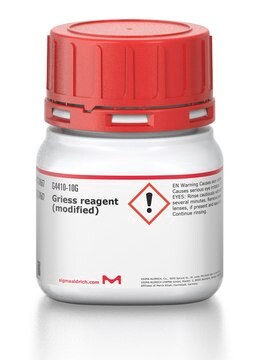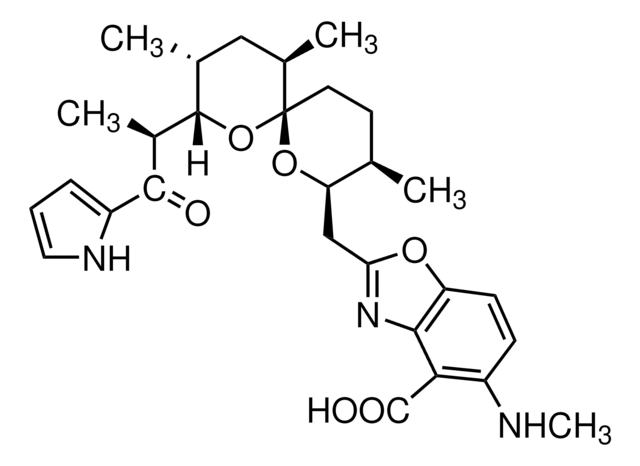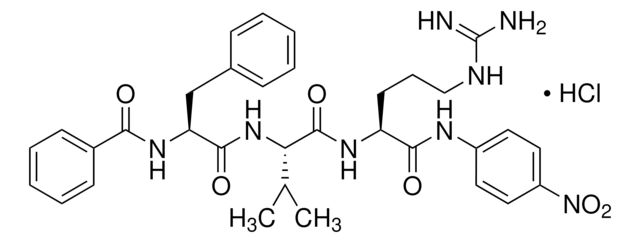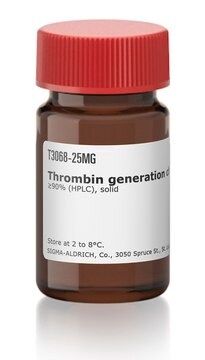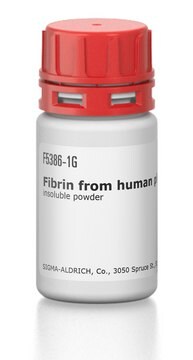H0393
Hirudin
recombinant, expressed in unspecified host, ≥7,000 ATU/mg protein, powder
Sign Into View Organizational & Contract Pricing
All Photos(1)
About This Item
Recommended Products
Product Name
Hirudin, recombinant, expressed in unspecified host, ≥7,000 ATU/mg protein (ATU = antithrombin units)
recombinant
expressed in unspecified host
Quality Level
form
powder
specific activity
≥7,000 ATU/mg protein (ATU = antithrombin units)
mol wt
~7 kDa
solubility
pyridine: soluble
water: soluble
shipped in
dry ice
storage temp.
−20°C
Looking for similar products? Visit Product Comparison Guide
Application
Antithrombotic efficacy by parenteral route is substantially prolonged by incorporation into cationic liposomes, which act as a sort of sustained-release device.
Physical properties
The anticoagulant hirudin is a ~7 kDa acidic protein containing 65 amino acid residues. It occurs naturally in leeches (Hirudo medicinalis). It is the most potent natural inhibitor of both soluble and clot-bound thrombin. Hirudin binds thrombin with high affinity and covers more than 20% of the surface area of thrombin, occluding both the active site and exosite I (fibrinogen and PAR recognition site). This coverage blocks thrombus growth and platelet activation. Hirudin is not metabolized in the bloodstream of humans and is eliminated unchanged via kidney filtration. Native hirudin contains a sulfated tyrosyl residue (Tyr63), three disulfide bridges, and a high proportion of dicarboxylic acids. Hirudin is not glycosylated, and lacks tryptophan, arginine, and methionine residues. At least 20 isoforms have been identified and sequenced.
This recombinant hirudin product corresponds to the HV-1 variant sequence, with the exception that the Tyr63 residue is not sulfated.
Unit Definition
One antithrombin unit (ATU) will neutralize one NIH unit of thrombin at 37 °C, based on direct comparison to an NIH thrombin reference standard.
Reconstitution
Hirudin is soluble in water. The literature cites the use of "Dilution Fluid II" (35.7 mM acetic acid, 35.7 mM sodium diethyl barbiturate, 0.85% NaCl, 1% bovine serum albumin, and 0.5% PEG, pH 7.4) to dissolve hirudin (500 ATU/mL) and thrombin. Hirudin is reported to be soluble in pyridine, but practically insoluble in alcohol, ether, acetone, or benzene.
Analysis Note
Protein determined by Lowry.
Storage Class Code
11 - Combustible Solids
WGK
WGK 3
Flash Point(F)
Not applicable
Flash Point(C)
Not applicable
Personal Protective Equipment
dust mask type N95 (US), Eyeshields, Gloves
Choose from one of the most recent versions:
Already Own This Product?
Find documentation for the products that you have recently purchased in the Document Library.
Customers Also Viewed
Hirudin as an inhibitor of thrombin.
Markwardt, F.
Methods in Enzymology, 19, 924-932 (1970)
[The reaction between hirudin and thrombin].
F MARKWARDT et al.
Hoppe-Seyler's Zeitschrift fur physiologische Chemie, 312(1-3), 85-98 (1958-01-01)
Hirudin and hirudin-based peptides.
S R Stone et al.
Methods in enzymology, 223, 312-336 (1993-01-01)
Serdar Duzgun et al.
Indian journal of plastic surgery : official publication of the Association of Plastic Surgeons of India, 47(1), 102-108 (2014-07-06)
The effect of recombinant hirudin, which is the most powerful antithrombotic agent, on flaps with venous insufficiency was investigated. Oedema and congestion are frequent on flaps, causing necrosis unpredictably. Venous insufficiency and thrombosis are experimentally and clinically more frequent than
R Bischoff et al.
Biochemistry, 32(2), 725-734 (1993-01-19)
Natural hirudin variant 2 with a lysine residue in position 47 (rHV2-Lys47) was produced in a genetically engineered strain of Saccharomyces cerevisiae as a secreted protein of 65 amino acids and purified to greater than 99% homogeneity. Only reversed-phase high-performance
Our team of scientists has experience in all areas of research including Life Science, Material Science, Chemical Synthesis, Chromatography, Analytical and many others.
Contact Technical Service
